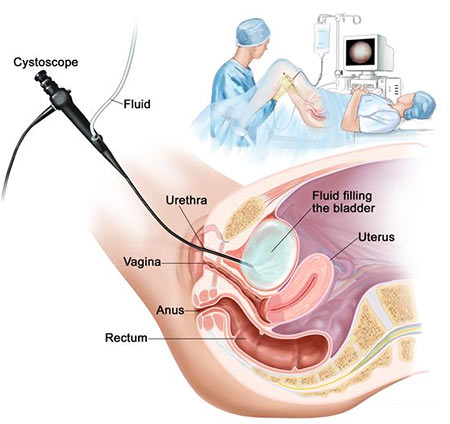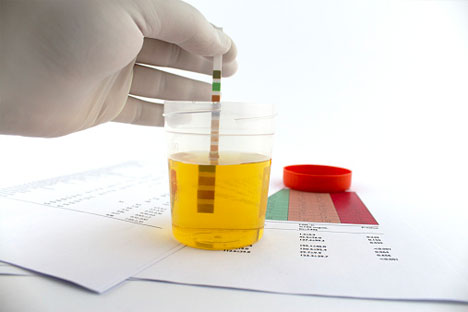Cystoscopy
Cystoscopy is a procedure to examine the inside of a patient’s bladder. Our gynecologists perform this procedure using a small thin camera inserted into the patient’s urethra and bladder. That camera is called a cystoscope. There are two types of cystoscopies; one is called a flexible cystoscope, which uses state-of-the-art fiber optics, which helps the cystoscope bend. The second type of cystoscope is called a rigid cystoscope that does not bend and is straight.
 In both types of cystoscopes, the OBGYN doctor can see within the bladder, and she can take pictures and display them on a screen, usually next to the patient. Your doctor, may choose to take a tiny biopsy (sample) of the bladder using another instrument passed through the cystoscope device if he notices an abnormality.
In both types of cystoscopes, the OBGYN doctor can see within the bladder, and she can take pictures and display them on a screen, usually next to the patient. Your doctor, may choose to take a tiny biopsy (sample) of the bladder using another instrument passed through the cystoscope device if he notices an abnormality.
Patients with symptoms such as recurrent urinary tract infections, blood in the urine, pain when urinating, abnormal cells in the urine, or difficulty emptying their bladder may require a cystoscopy procedure in Midtown or the Upper East Side of Manhattan.
Cystoscopy can help the gynecologist know if the patient’s bladder is fine inside or has a condition contributing to her symptoms. The specialist can also use cystoscopy to see how the patient is responding to treatment.
How is cystoscopy performed?
Usually, the patient will be awake for the treatment, though some may need a sedative to help with anxiety. It is not usually a painful procedure. The patient will change into a hospital gown, and then the gynecologist’s assistant will prepare the patient for the procedure. The patient will be placed in a lithotomy position (lying down, legs in stirrups), and a doctor will clean her urethra with an antiseptic solution which helps prevent infection. Then the patient will receive a local non-painful anesthetic jelly placed directly into the urethra. This jelly helps smooth the insertion of the cystoscope through the urethra.
The specialist can perform cystoscopies while the patient is awake or sleeping
The gynecologists in Manhattan are now ready for the procedure. They will ask the patient to take a deep breath and then insert the cystoscope through their urethra and the bladder. The bladder is then filled up with sterile water so that the doctor can inspect the lining. They will then carefully check all aspects of the inside of the patient’s bladder, looking for any abnormalities and taking pictures.
The patient may feel the discomfort of her bladder filling, which is normal. If there is an abnormality, the gynecologist may take a small sample and send it for evaluation under a microscope; this is called a biopsy. Once she has completed the examination, the gynecologist will remove the cystoscope from the patient’s bladder and urethra.
The whole cystoscopy procedure will take about 5-10 minutes. After it, the gynecologist will explain what she found on her exam. Then the patient can relieve herself in the restroom.
Under certain conditions, the gynecologist may recommend a general anesthetic to perform the cystoscopy procedure.
What are the expected side effects or complications with cystoscopy?
 Most cystoscopies have no side effects, but, as with any procedure, it is invasive. After it, many patients will report a mild burning, especially during urination, and an increased sense of urgency to urinate. Usually, this feeling will pass after one day. Patients may also notice that their urine looks pinkish with a small amount of blood in it. This issue is common, especially if the gynecologist took a sample of the lining.
Most cystoscopies have no side effects, but, as with any procedure, it is invasive. After it, many patients will report a mild burning, especially during urination, and an increased sense of urgency to urinate. Usually, this feeling will pass after one day. Patients may also notice that their urine looks pinkish with a small amount of blood in it. This issue is common, especially if the gynecologist took a sample of the lining.
Less commonly, the patient will develop a urinary tract infection after the procedure, which can cause pain with urination and or fevers. It is essential to call the gynecologist right away to prescribe the appropriate antibiotics if this should happen.
With the advent of minimally invasive procedures, we can now use tiny cameras to see what is happening inside the bladder precisely without surgery.
Most uncommonly, the cystoscope can cause an injury or hole in the bladder if this should happen. Depending on the injury’s location, the patient may need a catheter placed in the bladder for a few days until it heals.
The patient should immediately let the gynecologist know if she is experiencing any severe pain or bleeding, has urinary tract infection symptoms, or sees that she continues to bleed for longer than two days after the procedure.
Have questions about Cystoscopy Procedure in NYC? Visit the gynecology center in Midtown or on the Upper East Side to schedule an appointment with one of our doctors today.
Updated on Sep 23, 2023 by Manhattan Women’s Health and Wellness
Best-in-class
New York Gynecology Clinic
Manhattan Specialty Care in the Press

Call now to make an appointment with our highly rated Manhattan Gynecology doctors regarding your health. We look forward to seeing you!
book online now
(212) 378-9985
New York City Locations:
Manhattan Women's Health & Wellness (Upper East Side)
983 Park Ave, Ste 1D17
New York, NY 10028
(212) 389-1904
Manhattan Women's Health & Wellness (Midtown)
56 W 45th St, Ste 815
New York, NY 10010
(212) 677-7654
Manhattan Women's Health & Wellness (Union Square)
55 W 17th St, Ste 104
New York, NY 10011
(212) 378-9985